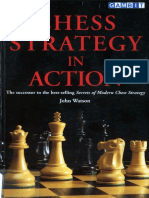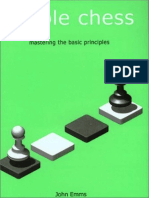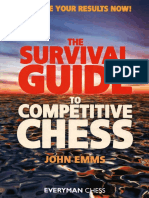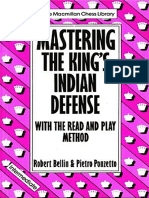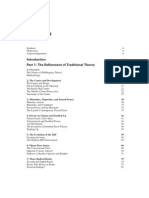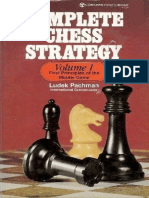0 ratings0% found this document useful (0 votes) 374 views274 pagesUntitled
Copyright
© © All Rights Reserved
We take content rights seriously. If you suspect this is your content,
claim it here.
Available Formats
Download as PDF or read online on Scribd
Advances since Nimzowitsch
AS OM ET Crest�Secrets of Modern
Chess Strategy
Advances Since Nimzowitsch
John Watson
AMBEAT�First published in the UK by Gambit Publications Ltd 1998
Reprinted 1999, 2000, 2001, 2002, 2005
Copyright © John Watson 1998
‘The right of John Watson to be identified as the author of this work has been asserted in accordance
with the Copyright, Designs and Patents Act 1988.
All rights reserved. This book is sold subject to the condition that it shall not, by way of trade or
otherwise, be lent, re-sold, hired out or otherwise circulated in any form of binding or cover other
than that in which it is published and without a similar condition including this condition being
imposed on the subsequent purchaser.
A copy of the British Library Cataloguing in Publication data is available from the British Library
ISBN 1 901983 07 2
DISTRIBUTION:
Worldwide (except USA): Central Books Ltd, 99 Wallis Rd, London E9 SLN.
Tel +44 (0)20 8986 4854 Fax +44 (0)20 8533 5821. E-mail: orders @Centralbooks.com
USA: Continental Enterprises Group, Inc., 302 West North 2nd Street, Seneca, SC 29678, USA.
For all other enquiries (including a full list of all Gambit chess titles) please contact the publishers,
Gambit Publications Ltd, P.O. Box 32640, London W14 OJN. E-mail: info@gambitbooks.com
Or visit the GAMBIT web site at http://www.gambitbooks.com
Edited by Graham Burgess and Chris Baker
Typeset by John and Petra Nunn
Printed in Great Britain by The Cromwell Press, Trowbridge, Wilts.
109876
Gambit Publications Ltd
Managing Director: GM Murray Chandler
Chess Director: GM John Nunn
Editorial Director: FM Graham Burgess
German Editor: WFM Petra Nunn�Contents
Symbols
Dedication
Acknowledgements
Introduction
Part 1: The Refinement of Traditional Theory
1: Overview
The Nature of Middlegame Theory
Methodology
2: The Centre and Development
The Centre and Tempi
Pawn-Grabbing in the Opening
The Really Big Centre
The Mobile Central Pawn-mass
Surrender of the Centre
3: Minorities, Majorities, and Passed Pawns
Minority Attacks
Majorities and Candidates
Passed Pawns and the Blockade
The Lustful Contemporary Passed Pawn
4: Pawns: in Chains and Doubled Up
Nimzowitsch’s New Ideas
Nimzowitsch and Doubled Pawns
An Old Dispute
The Evolution of Doubled-Pawn Theory
Tripling Up
5: The Evolution of the IQP
Framing the Issue
The Modern IQP Environment
6: Minor-Piece Issues
The Conventional View
Opposite Colours Attract?
Folklore or Reality? Queens and Knights
7: Those Radical Rooks
Seventh and Eighth Ranks
Rooks Who Roam on Ranks
Drawish Endings?
Ana�4 SECRETS OF MODERN CHESS STRATEGY
8: Royalty in Our Times
The Nimzo-Kingdian Defence
King Adventures after Nimzowitsch
9: Assorted Topics
Manoeuvring and Weaknesses
Exchanging, Old and New
Overprotection: A Few Remarks
Part 2: New Ideas and the Modern Revolution
1: Overview
The Death of Chess Revisited
2: Rule-Independence
The Demise of the General Rule; Examples from Practice
Description Versus Reality
The Royal Guard and How It Strays
Affording Common Courtesy to a Horse
3: Modern Pawn Play
New Treatments of the Pawn-chain
The Positional Pawn Sacrifice
Are Your Pawns Really Backward?
The New Relationship of Flank to Centre
Other Pawn Issues
4: The Modern Bishop
All That Fianchettoing
The New Morality of Bad Bishops
The Bishop-pair Reconsidered
5: The Contemporary Knight
They Live on the Edge
Optical Illusions
Are You Feeling Superfluous?
6: Bishops versus Knights 1: One-on-One
The Minor Pieces Face Off
7: Bishops versus Knights 2: Minor-Piece Pairs
Against all Odds: Championing the Steeds
a) Classical Case: Permanent Weaknesses
bi Space/Centre for Bishops: An Obscure Trade-off
co) Reversing the Conventional Wisdom
Vengeance of the Bishops
A Practical Digression
8: The Exchange Sacrifice
Origins
151
163
163
169
169
169
175
178
191
195
197
197�CONTENTS
A Conceptual Leap
Petrosian’s Patent
The Unfinished Product
9: Prophylaxis
Nimzowitsch’s Notion
Modern Prophylaxis: Pervasive Prevention
10: Dynamism: The Modern Difference
What is Dynamism?
Accumulation or Plunder?
Dynamic Balance and Planning
Optical Advantages versus Elasticity
11: Time and Information
Information Theory and Chess
Remis?
Time and Reversed Openings
Today’s Symmetry is Tomorrow’s Opportunity
12: The Initiative Dance: Some Musings
The Mysteries of Momentum: What is an Advantage?
Dynamism and Provocation
13: The Modern Opening Reconsidered
The Paradox of Alekhine
The Analytical Revolution
An Overview of Contemporary Theory
The Avant-Garde
14: Playing Modern Chess/Conclusion
Conclusion
Bibliography
Index of Players
Index of Openings
199
202
205
211
211
214
222
222
224
227
228
231
231
232
233
236
238
238
244
244
247
248
262
265
267
268
270
272�Symbols
+ check
++ double check
# checkmate
x capture
im brilliant move
: good move
1 interesting move
7 dubious move
7 bad move
ne blunder
Ch championship
1-0 the game ends in a win for White
‘)-\ the game ends ina draw
0-1 the game ends in a win for Black
(D) _ see next diagram
Dedication
To Tal Shaked and Patrick Hummel, students who are gradually teaching me about chess
Acknowledgements
Thanks to Graham Burgess and John Nunn, for their suggestions and patience, and to the folks at
ChessBase, who supplied me with never-ending data. I am also grateful to IM Larry D Evans, for
both his friendship and the use of his fine library.�Introduction
In Chessman Comics #2', Chessman and Zug-
zwang are seen watching the chess western
movie “Fort Blunder”, starring General Princi-
ple and Chief Alternative, in which the follow-
ing dialogue takes place between the General
and his assistant: “General Principle, sir,
you’ve almost killed off them Old Indians!”;
“Yup, but I fear there are new Indian formations
coming!”. At the time of Nimzowitsch, the
world of chess was undergoing major transfor-
mations which would indeed challenge the gen-
eral principles then dominating chess theory. In
fact, these changes, most apparent in the new
Indian formations championed by Nimzo-
witsch himself, ultimately cast into doubt the
very validity of having such things as ‘general
principles’ at all. Nimzowitsch challenged older
theory, and his successors ushered in an era of
pragmatism, rejection of dogmatism, and ana-
lytical research which still characterizes chess
today. My task in this book has been to identify
the most important changes in chess theory
which distinguish modern from classical chess
thought.
Right away, since I am aware how daunting
this book may seem to the reader, I want to
make some organizational and philosophic
points. First, defining what is ‘modern’ in chess
has been a tricky task; as a general guideline, I
have chosen 1935, the year of Nimzowitsch’s
death, as a dividing point between modern and
pre-modern play. Of course, there was no revo-
lution in chess thought during that particular
year; so ideas which I characterize as ‘modern’
were not necessarily unheard of before 1935,
and naturally, some of the concepts I will em-
phasize have only recently entered the general
consciousness. But when the reader is confused
as to why I am designating an idea as ‘modern’
or ‘classical’, he or she is advised to take this
somewhat arbitrary dividing point as a guide.
Unfortunately, the structure of this book is a
bit tricky, and I hope the reader will forgive me
if I make repeated explanations about it. Part |
is designed to make the student feel comfort-
able with classical theory and with Nimzo-
witsch’s revisions to that theory. It seemed only
fair to the average chess fan to explain a bit
about older theory and to lay some foundation
for later claims of radical change. But Part 1
also opens the subject of the modern ‘evolu-
tion’ of the older theory. Although the distinc-
tion is a bit arbitrary, I have introduced in Part 1
what could be termed ‘natural’ developments of
older theory, whereas Part 2 is devoted to ‘revo-
lutionary’ changes, for example, ones which re-
fute older principles or involve fundamental
philosophical changes. Thus, both parts fulfil
the mandate of the book’s subtitle (‘Advances
Since Nimzowitsch’); but Part 2 covers, with a
minimal review of past thought, the new ideas
which radically distinguish modern play.
Hopefully, the chapter and section introduc-
tions will help the reader to make sense of these
distinctions. At the risk of becoming tedious, I
will repeat and expand upon what I have just
said about the organization of this book in the
first chapter of Part 1, and then again, to a lesser
extent, in the first chapter of Part 2.
Next, I want to discuss my stylistic approach
to this book, including the use of statistics and
my choice of exemplary material. The first
point to make is that this is nor an instructional
book. While I would hope and assume that its
study can only help one as a player, that is not
its primary purpose. Nor am I writing a com-
plete guide to chess middlegame theory, in the
way that well-known books written by Pach-
man or Euwe and Kramer have done. The book
before you is a sort of middlegame book, with
numerous examples from opening theory, since
the opening and middlegame are no longer
1 The author referring to his own oeuvre! Chessman Comics #2; Watson & Myreng;
Chess Enterprises Inc., 1982.










